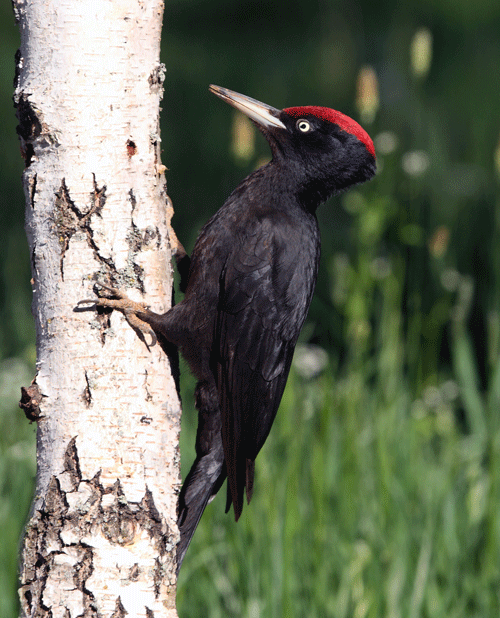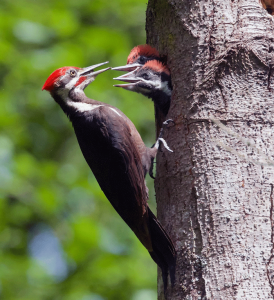
If you’ve ever wandered through the woods and heard the gentle, rhythmic tapping of wood you’re probably hearing the sounds of a woodpecker. With over 200 species found across the globe, woodpeckers are well-established and appreciated by bird-watchers everywhere.
In this article, we’re going to discuss how to spot a woodpecker on the basis of their appearance, tracks, droppings, and sounds. We will also discuss some more general information about woodpeckers such as their typical diet and other fun facts.
Woodpecker Solutions
Woodpecker Description
Woodpeckers are immediately recognized by their long, sharp beaks that they use to chisel away at tree bark. Rather than build a traditional bird nest, woodpeckers carve away hollow spaces in tree trunks to create makeshift “rooms.”
The most common woodpecker is the Downy Woodpecker and it is black and white in appearance with white spots running up and down their wings. The Downy woodpecker, like many other species, also has a recognizable red tuft of hair on the back of their head.
Although the Downy woodpecker’s beak isn’t as long as other species, it’s still very sharp. Woodpeckers like to use their beaks to nest in dead or dying tree trunks. Woodpeckers are also nomadic, meaning they do not like to stick to one area for too long.
Woodpeckers usually like to nest in the following trees: pine, maple, birch, cottonwood, and oak. Remember, these birds prefer dead or dying wood as this makes it easier for their beaks to carve into the bark. The majority of the nest-building process is performed by the male, however, both the male and female work to create their nests.
The nest-building process usually takes at least 2 weeks to complete and yields a nest size of approximately 100mm x 300mm. These nests, or cavities so to speak, usually house anywhere from 3-10 eggs.
Because woodpeckers are arboreal animals, they rarely make their way to the ground floor. These birds spend most of their time on the sides of tree branches or inside their nests. Due to this behavior, tracking woodpeckers based on their tracks is inefficient.
The tell-tale sign of woodpeckers is the 50mm (on average) entry hole they leave on the sides of tree trunks. As for droppings, woodpecker dung appears to resemble cigarette ashes. These droppings are usually found near or around their nesting tree.
Unlike the song-like call of most birds, woodpeckers emit a shrill like screech. These calls may be accompanied by the pecking of wood (drumming) or low-frequency chirrs. Perhaps the best way to identify and locate woodpeckers is by their calls or nesting habits.
The woodpecker diet is similar to other avian species, encompassing bugs, sap, nuts, fruits, and seeds. If you have a bird feeder in your yard, it is likely that you’ll attract a woodpecker at some point. You can also expect to find woodpeckers in forested areas near these food sources.
Although these animals are omnivores, they tend to eat more plant matter than insects. Woodpeckers also store food for the colder months in their nests or nearby food caches. If you’re birdwatching, keeping an eye on a woodpecker’s flight routes may reveal where their food caches are.
Woodpeckers, although cute, are actually rather aggressive and territorial birds. From mating to nest-building, this species is generally ritualistic and follows a power-complex. Woodpeckers will defend their nest from other birds, often instigating fights with other species before they have a chance to decide if the woodpecker is worth attacking.
These birds are smart and in some ways, more equipped to survive than other avian species. By insulating their nests within trees, woodpeckers conceal themselves from predators and limit their exposure to other creatures.
Unfortunately, woodpeckers are often plagued by the growing rise of deforestation efforts. Without trees, woodpeckers do not have a home. Woodpeckers rely on a well-forested habitat that provides food, shelter, and security to harbor future broods.
Some people also view woodpeckers as a nuisance when they drum against houses and sheds. The reason they do this is believed to be an expression of territorial dominance before the breeding season. Woodpeckers may also do this to create nests or food caches if they mistake your home’s siding for an ideal home prospect.
Removing these birds may be a necessary evil to keep your house safe; just be sure that you appropriately research how to handle woodpeckers to prevent disrupting their part in the overall ecosystem.
Q: “Woodpecker drumming is so loud and obnoxious, why doesn’t it hurt them to annoyingly peck like that?”
A: This is actually a really good question and easy to sympathize with. Although annoying to us, woodpecker drumming does not bother the bird at all. In fact, these birds can peck somewhere between 10-20 times per second and it does not bother them in the slightest.
Woodpeckers have reinforced skulls that evenly distribute the force of each peck. Although they’re fragile creatures compared to you and me, this anatomical structure prevents them from getting a headache as they peck away.
Q: “What are some of the common predators to woodpeckers?”
A: Foxes, dogs, feral cats, hawks (birds of prey), and snakes are all common woodpecker predators. However, one of the biggest predators to woodpeckers is humans. By deforesting their habitat, we significantly reduce their chances of finding adequate nesting locations.
This reduction can increase the number of territorial conflicts which leaves the birds vulnerable to predation.
Q: “Any comment on Woody the Woodpecker?”
A: Funny story, although Woody is easily the most famous woodpecker of all time, he doesn’t actually resemble a woodpecker. Woody’s coloration was likely done for the sake of cartoon-style recognition. Even the anatomical structure of Woody does not bear much resemblance to any woodpecker species.
However, who are we to ruin the fun – Woody is still an adorable lil’ woodpecker.
 Identifying and spotting woodpecker nests is not as easy as other bird species. You can’t simply gaze up into the woven tree branches for an out of place mass of twigs, pine straw, and dirt. Woodpeckers live most of their lives inside and around trees.
Identifying and spotting woodpecker nests is not as easy as other bird species. You can’t simply gaze up into the woven tree branches for an out of place mass of twigs, pine straw, and dirt. Woodpeckers live most of their lives inside and around trees.
Before we discuss the appearance of woodpecker nests, it’s important that you learn how to identify other signs of woodpecker inhabitance. To do this, look for telltale woodpecker signs such as their ideal habitat, droppings, or sounds (calls and drumming).
Woodpeckers tend to nest in dead or dying trees because their bark is significantly easier to peck into. Woodpeckers will nest in most tree species, but more commonly they nest in oak, maple, beech, and pine trees. The ideal woodpecker habitat would be well forested, near large populations of insects, or close to food sources such as fruits or nuts.
Woodpeckers are fairly common birds all around the globe (with the exception of Madagascar, New Zealand, or Australia), so finding them will not be terribly difficult. In fact, these birds are commonly labeled "backyard birds". Once you feel that you've identified an ideal habitat for them it's time to listen.
Woodpeckers do not sing or call like robins or blue jays; instead, woodpeckers make a very loud shrill-like call. This call may also be accompanied by the tell-tale sound of woodpecker drumming. Drumming is the sound that the woodpecker makes when they hammer their beak into the side of trees or houses. This sounds like very fast-paced tapping and is hard to miss.
Identifying Woodpecker Nests:
If you audibly hear woodpecker sounds and recognize their habitat, chances are there is a woodpecker nesting nearby. To locate their nest, look for dead or dying tree branches. Keep in mind, there can be a perfectly healthy tree with patches of dead or dying bark.
You want to look for holes in these trees. These holes will be approximately 50mm in width or roughly 2 inches. You may hear the chirping of baby woodpeckers from these holes and perhaps birds may poke their head out every now and then. These woodpecker holes will likely be the only part of the nest that is directly visible to you.
Woodpecker nests are usually not very complex, but they are quite sheltered. On the inside, woodpecker nests can be roughly 100mm x 300mm. This is enough space to accommodate both the male and female woodpecker as well as a nest of 3-10 eggs. An active woodpecker nest will likely have the presence of droppings under their nest or around their tree. Woodpecker droppings are commonly likened to cigarette ashes - white and black, very cylindrical in shape.
Woodpeckers are somewhat nomadic so their nest may or may not be inhabited for too long. At most, woodpeckers may stick around an area for roughly a year before moving on to a different area. If you find woodpeckers, please appreciate them from a distance as these birds can be quite aggressive and territorial when they feel threatened.
 Although woodpeckers find themselves nesting in trees, they often (not purposefully) bother humans when they find our homes and buildings. Woodpeckers use their beaks to carve away at dead or dying trees to construct safe spaces for nesting.
Although woodpeckers find themselves nesting in trees, they often (not purposefully) bother humans when they find our homes and buildings. Woodpeckers use their beaks to carve away at dead or dying trees to construct safe spaces for nesting.
If you're concerned that a woodpecker may be damaging the side of your home or neighborhood telephone poles, then keep reading. This article will help explain what woodpecker damage looks like and why the birds are doing it. In short, woodpecker damage comes in the form of small, non-uniform holes on wooden surfaces. While these holes are inherently harmless to trees, they can appear very unsightly on the edge of your home.
Why do Woodpeckers Want to Damage my House?
- It could be for food.
Although woodpeckers primarily use their beaks for nest-building, they may also use this behavior for food. Carpenter bees/ants like to nest in wooden substrates and the woodpecker is keen to take advantage of this. If the side of your house is home to a colony of insects, you may need to get rid of the bug problem to deter the birds.In most cases, woodpeckers will not just go pecking into your house for no reason. If the birds notice the insects, they will come pecking.
- A display of dominance.
Male woodpeckers sometimes find the side of your home as the perfect surface to tap away their display of dominance and reproductive-readiness. Fortunately, if this is the reason for their disturbance it is usually short-lived and only practiced before the breeding season. While it may be a temporary annoyance, at least it isn't going to be a long-term problem. - The bird wants to make a nest.
As humans, we're very intelligent. However, we sometimes make mistakes - woodpeckers are no different. A woodpecker couple may come across your house and believe it to be the perfect nesting ground! However, their excitement will likely be short-lived when they discover that the side of your house lacks the depth needed for a nest.This discovery is usually quickly made, and the birds will move on with just a single hole to repair.
- The bird wants to create food storage.
Woodpeckers have been known to create food caches in very interesting places. From roof tiles to totally separate holes in trees, these birds like to stock up on food for the colder season. These entry holes are usually the same size as their nests; however, the depth is significantly less - just enough to accommodate the food.Simply scaring off the birds or making yourself appear as a "predator" to the birds is enough to deter this sort of behavior.
Although woodpecker damage is annoying, these creatures are simply beautiful, and they play a huge part in the local ecosystem. When handling their damage, please seek the help of an expert to ensure that you do not harm the animals and that the integrity of your house is maintained in the best way possible.
